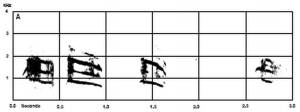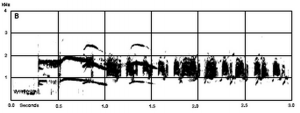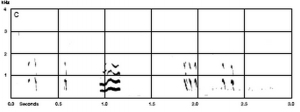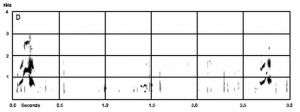Songs & Calls:
The following descriptions of loon calls are from unpublished work by S. Douglas as described in the Birds of North America article on red-throated loons.
Unlike other loons, the red-throated loon does not have a song or a yodel. However, they are notable in the prolific nature of their vocalization repertoire. Both males and females are extremely vocal, though females usually emit sound at a lower frequency. While they don’t have a learned, taught song, Gavia stellata do have some vocalizations that are structurally and harmonically complex.
In fact, the Plesiosaur Call, pictured in sonogram, is this loon’s equivalent to the standard yodel. It is a far-carrying, structurally complicated call given by both sexes and by both breeding and non- breeding birds. This call is often given as a duet, as red-throated loons are monogamous birds. The call is most often used in matters of courtship, both in forming and affirming pair bonds between individuals. This also draws a parallel between this call and a typical loon’s song in that the Plesiosaur plays an important role in pair bonding. However, it is sometimes also used in territory disputes.
The loon also has a variety of calls, including the wail. This call is the most universally-use. It is made by both sexes and generally when the bird’s head is low to the water. It begins at a low frequency and gets lower by the end of the note. It is used as a defense mechanism when predators swim in to the territory via the water or when predators fly over head. The call is made as a duet about half the time.
The Coo and the Low Shrill are similar in their function, though they are each unique to a sex. The Coo is a male call, made at a low frequency. It is short and very structurally simple; it may be made as a single call or as a cluster of Coos. This can be called an Extended Coo, though it does not differ in purpose. The Coo is given near the nest area to both mates and young. The Low Shrill is the female’s call directed at her mate and young near the nest. It also has a similar harmon structure, increasing in frequency in the middle and ultimately lowering. High Shrills are a variation of this call; they are greater in amplitude, longer, at a higher frequency, and more intense. These are given to young when they are learning to fly.
The red-throated loon also has a range of other vocalizations that are more simple. The Quack, sometimes called a Quark or Kark, is a single-syllable, simply structured call. It is sexually monomorphic call and is used in flight by breeding and non-breeding loons, though more frequently by non-breeding individuals. The Staccato call is short and at a low frequency. It is given by both members of a pair when feeding young, often paired with rapid head- bobbing. The Chirp is a call given by chicks when begging to be fed.
(Source: http://bna.birds.cornell .edu/bna/species/513/articles/sounds. Sonograms: http://bna.birds.cornell.edu/bna/species/513/galleries/figures/figure-2/image_popup_view)
SONG LEARNING
Though there is a lack of research regarding the song learning of the red-throated loon, we do know that they do not have a complex, taught song.
This eliminates the possibility of tutors, which are present in other populations of loons. Typically, male loons have unique calls, different than other individuals in the habitat. The yodel stays stable from year to year, but does actually change if the loon changes location.
However, the red-throated loon is different. The Plesiosaur Call is structurally similar to the yodel, though more research must be done to determine how different the call can be from pair to pair. The call may develop unique structure within a pair bond.
It seems that song are innate to red-throated loons, though the more complex calls given as duets may ultimately be found to be taught or unique to individuals upon further research.
(Source: http://www.bsc–eoc.org/download/BWCwi10.pdf)
Photos:
http://upload.wikimedia.org/wikipedia/commons/b/b3/Gavia_stellata_-Iceland_-swimming-8.jpg
http://www.howardsview.com/BrigBarnegatDec9th_11/zzzRed-throatedLoon.jpg https://c2.staticflickr.com/2/1044/660792518_b4cc8b188e.jpg




